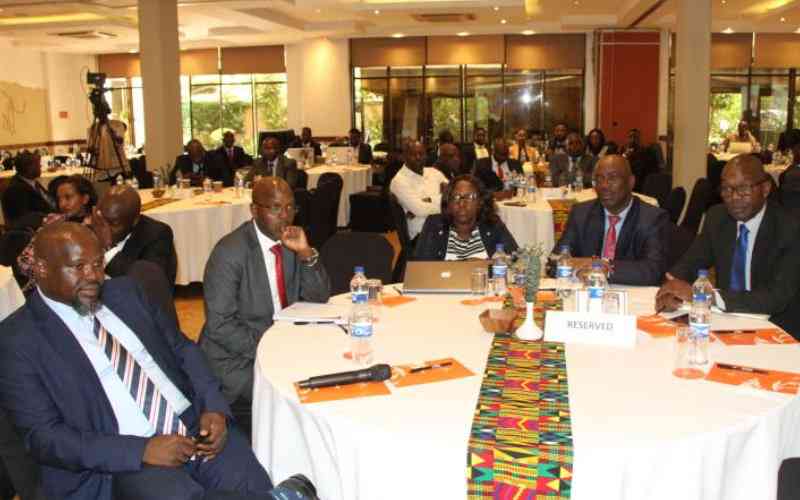Kenya recently rebased its economy, which in a layman’s language means recalculating the gross domestic product (GDP), the measure of the country’s economy.
Kenya’s GDP per capita is now $1,269, (say Sh112,941) which has propelled the country to the superior category of ‘lower middle income’. This ‘lower middle income’ status is a World Bank grouping of 53 countries whose average income lies between $1,036 and $4,085 (GDP per capita).
Kenya joins the league of the top 10 biggest economies in Africa (out of 54) and has surpassed the recently re-based economies of Ghana and Ethiopia. The country’s GDP is now $53 billion (Sh4.8 trillion) making it the fourth largest economy in sub Saharan Africa after Nigeria, South Africa and Angola.
However, to ordinary Kenyans, this should be translating to increased school enrolment, better housing, healthcare, access to clean water and food security. But this is not the case. Two reports released last week show the opposite. The gap between the rich and poor is now wider. Most Kenyans cannot make ends meet. A third of Kenyans are extremely poor. In more than a dozen of counties, more than half of the population spends Sh1,440 or less per month, translating to about Sh48 a day, an amount that cannot even buy a packet of unga.
The Socio-Economic Atlas of Kenya and The Exploring Kenya’s Inequality—Pulling Apart or Pooling Together? reports show a country with wide disparities in the quality of life in various counties. The findings are in line with estimates from the World Bank that four in ten Kenyans are living below the poverty line. Kenya National Bureau of Statistics (KNBS) in the Exploring Kenya’s Inequality report says nearly half of the Kenyan households cannot afford three meals a day.
KNBS in this report, which it partnered with Society for International Development (SID) – East Africa, says in Kenya, 45.2 per cent of the population lives below poverty line, which is a threshold below which people are deemed poor. Using consumption expenditures, in 2005/06, the poverty line was estimated at Sh1,562 per adult for rural areas and Sh2,913 for urban households.
The report shows half of the people in rural areas and one third in urban areas live below poverty line, a difference of 18 percentage points between rural and urban areas. More worrying is that 21 one counties have more than half of their people living in abject poverty. Incidence of poverty is more pronounced in the Northern and Coastal regions of the country, two regions that have been heavily neglected by past governments. But this is significantly lower in others especially in Nairobi and the Central region.
For instance, roughly eight out of every ten people in Turkana, Mandera and Wajir Counties are poor. Also, the proportion of individuals below the poverty line in the potentially oil-rich county of Turkana (87.5 per cent) is four times that in Nairobi, which has the lowest poverty at 21.8 per cent.
Marsabit, Tana River, Samburu, Kwale, West Pokot, Isiolo, Makueni, Kitui and Busia have more than half of their population living below the poverty line. This is the scenario in Garissa, Kilifi, Elgeyo-Marakwet, Baringo, Kisii, Bomet, Nyamira, Taita Taveta and Migori. In most of these counties, households expenditure is as low as Sh1,300 per month, which is about Sh43 a day. KNBS data shows that household expenditure in Kenya averages Sh3,440 per adult per month nationally. However, household expenditures per adult per month are Sh2,270 in rural areas compared with Sh6,010 in urban areas. Yet, over the last three decades, worldwide poverty has fallen from 40 per cent to under 20 per cent.
Dr X.N. Iraki, a lecturer at the University of Nairobi’s School of Business, attributes the growing disparity of consumption levels on deficient policies. However, he says as individuals “we too have not played our roles.”
“We love blaming the government. A good example is we want the government to educate and give jobs to our kids but the same government should not dictate the number of kids we should have,” Dr Iraki says.
On average, households in Nairobi County spend Sh7,200 per adult compared to Wajir county where on average, households spend Sh1,300.
The counties that have mean household expenditures of Sh2,200 and below per month per adult are also among the poorest in Kenya. These are Makueni, Kwale, Tana River, Samburu, West Pokot, Marsabit, Mandera, Turkana and Wajir.
More than half of households spend Sh1,440 or below in Turkana and Wajir and yet most of them (59 per cent and 68 per cent respectively) have seven or more household members.
Overall 44.6 per cent of the rural population spends Sh1,440 or less compared with only 2.6 per cent of the urban population.
By comparison, 34.1 per cent of the urban population spends Sh7,200 or above compared with only 1.5 per cent in rural areas, indicating large income differentials between urban and rural areas.
Stay informed. Subscribe to our newsletter
One third of Kenyans spend Sh1,440 or less per month while only 12 per cent spend Sh7,200 and above. “Inequalities in consumption expenditure are pronounced across counties. There are 12 counties where more than half of the population spends Sh1,440 or less per month.
The counties are also among Kenya’s poorest,” says KNBS in the report. The counties are Turkana, Wajir, Mandera, Tana River, Kwale, Marsabit, Samburu, West Pokot, Busia, Kitui, Makueni and Kilifi.
Large spenders
The proportion of those spending Sh1,440 or less in Turkana County is 129 times the proportion of those spending the same amount in Nairobi. The four counties with the largest proportion of their populations spending Sh7,200 and above are major towns of Nairobi, Mombasa, Kiambu and Kisumu.
The proportion of those spending Sh7,200 and above in Nairobi County is 112 times the proportion of those spending the same amount in Wajir County where, out of a population of 522,830 people, only 2,242 people can afford to spend Sh7200 and above. Dr Iraki says these statistics could be suspicious, and adds: “You rarely spend money in rural areas. Lots of rural areas are self-contained and may be richer than what economists say. For example they do not pay rent or buy food.”
He says it took Singapore about 40 years to transit into a developed country, so we do not expect overnight transformation despite a new government and new Constitution.
Way forward? Iraki advises the State to give incentives to the poor to rise. “Education used to the best channel and still is. Ensure taxes are put into the best use,” Iraki says.
“Let Kenyans take responsibility for their lives. End the blame game, and obsession with failure. End the culture of eating...even the seeds.”
 The Standard Group Plc is a
multi-media organization with investments in media platforms spanning newspaper
print operations, television, radio broadcasting, digital and online services. The
Standard Group is recognized as a leading multi-media house in Kenya with a key
influence in matters of national and international interest.
The Standard Group Plc is a
multi-media organization with investments in media platforms spanning newspaper
print operations, television, radio broadcasting, digital and online services. The
Standard Group is recognized as a leading multi-media house in Kenya with a key
influence in matters of national and international interest.
 The Standard Group Plc is a
multi-media organization with investments in media platforms spanning newspaper
print operations, television, radio broadcasting, digital and online services. The
Standard Group is recognized as a leading multi-media house in Kenya with a key
influence in matters of national and international interest.
The Standard Group Plc is a
multi-media organization with investments in media platforms spanning newspaper
print operations, television, radio broadcasting, digital and online services. The
Standard Group is recognized as a leading multi-media house in Kenya with a key
influence in matters of national and international interest.





